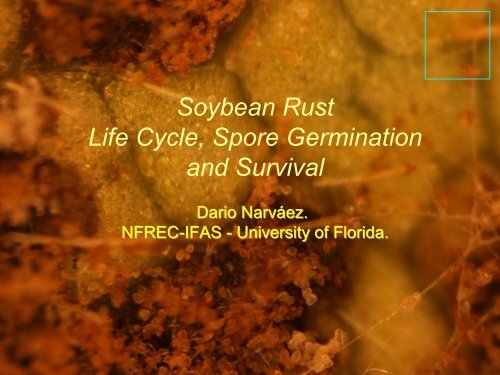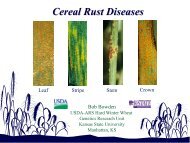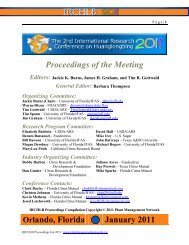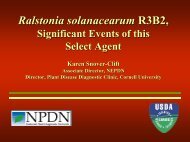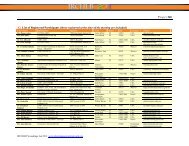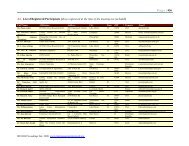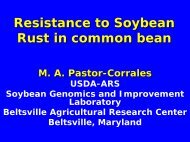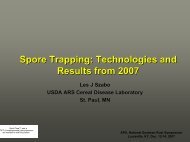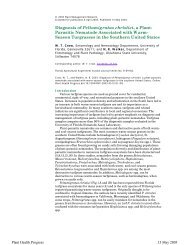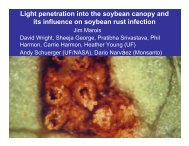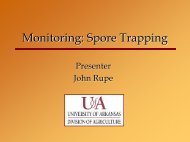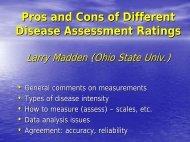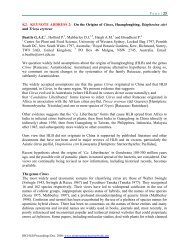Soybean Rust Life Cycle, Spore Germination and Survival - Plant ...
Soybean Rust Life Cycle, Spore Germination and Survival - Plant ...
Soybean Rust Life Cycle, Spore Germination and Survival - Plant ...
Create successful ePaper yourself
Turn your PDF publications into a flip-book with our unique Google optimized e-Paper software.
<strong>Soybean</strong> <strong>Rust</strong><br />
<strong>Life</strong> <strong>Cycle</strong>, <strong>Spore</strong> <strong>Germination</strong><br />
<strong>and</strong> <strong>Survival</strong><br />
Dario Narváez.<br />
NFREC-IFAS<br />
- University of Florida.
Why was the disease widespread?<br />
Three factors:<br />
Uniform susceptibility<br />
in the host plants<br />
The<br />
introduction<br />
of a pathogen<br />
An environment<br />
conducive to<br />
disease
TAXONOMY<br />
Phylum:<br />
Class:<br />
Order:<br />
Family:<br />
Full Name:<br />
Basidiomycota<br />
Urediniomycetes<br />
Uredinales<br />
Melampsoraceae<br />
Phakopsora pachyrhizi H. Sydow & Sydow<br />
Synonyms: Phakopsora sojae Fujikuro<br />
Malupa sojae (P. Hennings) Ono, Buritica, & Hennen comb. nov. (Anamorph)<br />
Phakopsora calothea H. Sydow<br />
Uredo sojae P. Hennings<br />
(For additional synonyms, see the following: Green, 1984; Ono et al., 1992
Reproductive Stages<br />
Alexopoulos, Mims, <strong>and</strong> Blackwell 1996<br />
Stage 0:<br />
Stage I:<br />
Stage II:<br />
Stage III:<br />
Stage IV:<br />
Spermatia not observed<br />
Aeciospores not observed<br />
Urediniospores common<br />
Teliospores observed but not<br />
common<br />
Basidiospores identified<br />
Alternate host is not known
Phakopsora pachyrhizi<br />
Obligate parasite<br />
Urediniospores<br />
Causes polycyclic disease<br />
Teliospores observed<br />
Unknown alternate host<br />
C. STONE<br />
Survives only in parasitic<br />
phase<br />
Wide host range; legumes
First rust symptoms often along major<br />
leaf veins
Sporulating pustule<br />
under a h<strong>and</strong> lens
Uredinia <strong>and</strong> Urediniospores
Infected <strong>Soybean</strong> Leaves
Infected Kudzu Leaves
Look-Alike Diseases<br />
• One of the challenges of identifying Asian soybean rust is that the<br />
early stage of the disease can look like other leaf diseases of<br />
soybean.<br />
Brown Spot<br />
Bacterial Blight<br />
Downy Mildew<br />
Bacterial Pustule
Look-Alike Diseases…continuation<br />
Cercospora leaf blight<br />
Frogeye leaf spot
Disease <strong>Cycle</strong><br />
B. Leite<br />
Infection<br />
development<br />
Free water on leaf surface<br />
Minimum: 6 h<br />
Optimun:12 - 14 h<br />
Penetration<br />
3-6 hr<br />
Direct &<br />
appressorium<br />
Symptoms show<br />
up 4-5 days after<br />
inoculation<br />
Reproduction<br />
Deposition<br />
Dry <strong>and</strong> wet<br />
M. Iamauti<br />
<strong>Germination</strong><br />
(optimum 18 0 C – 26 0 C)<br />
Penetration<br />
G.N.Agrios<br />
W.M.Paiva<br />
7-10 days occurs<br />
spore liberation<br />
Dissemination: wind<br />
Dissemination<br />
<strong>Survival</strong> ?<br />
J.T.Yorinori<br />
J.T.Yorinori<br />
One pustule<br />
releases spores<br />
for 3 weeks<br />
T. Mueller<br />
Teliospore<br />
Source: Modified from Embrapa
<strong>Soybean</strong> <strong>Rust</strong>- continued<br />
Once introduced to a new county, soybean rust could<br />
spread rapidly as the generation time<br />
for new inoculum can be as little as 9 days . . .<br />
Proportion of Diseased <strong>Plant</strong>s<br />
1<br />
0.8<br />
0.6<br />
0.4<br />
0.2<br />
0<br />
Disease Increase Over Time<br />
2005<br />
0 20 40 60 80<br />
Days After <strong>Plant</strong>ing<br />
. . . <strong>and</strong> in the U.S.,<br />
there is little variation<br />
in cultivars.<br />
2006?<br />
This chart depicts the exponential<br />
spread of a soybean rust epidemic<br />
in a field.<br />
Source: SASPP.org 2002
The frequency <strong>and</strong> amount of rainfall is a<br />
major driving force for the incidence <strong>and</strong><br />
severity of soybean rust
Environment <strong>and</strong> <strong>Soybean</strong> <strong>Rust</strong><br />
‣ Temperatures between 13 o C <strong>and</strong> 26 o C<br />
• Maximum infection at 20 to 23 0 C<br />
• No lesions >28 o C<br />
‣ Frequency of rain events<br />
• 12-15 rain days per month<br />
• Late vegetative to late reproductive growth stages<br />
‣ Duration of leaf wetness<br />
• 6-12 continuous hrs<br />
‣ Relative Humidity between 75-80 % required for spore<br />
germination <strong>and</strong> infection
<strong>Spore</strong> <strong>Germination</strong>
<strong>Spore</strong> germination pattern<br />
% de germinação<br />
% <strong>Germination</strong><br />
100<br />
80<br />
60<br />
40<br />
20<br />
0<br />
0 5 10 15 20<br />
dias após a coleta<br />
Days after collecting spores
<strong>Spore</strong> germination<br />
Polystyrene coated slide<br />
B. Leite
Percentage of Phakopsora pachyrhizi germ tube inhibition after exposure to four fungicide<br />
formulations: Chlorothalonil technical, Echo 720, Tebuconazole technical <strong>and</strong><br />
Tebuconazole 3.6 F.<br />
Poster #47 Breno Leite,<br />
Jim Marois <strong>and</strong> D.<br />
Wright.<br />
In vitro <strong>and</strong> greenhouse<br />
trials of the fungicides<br />
chlorothalonil <strong>and</strong><br />
tebuconazole.<br />
Control line represents the % germ tube formation in deionized water. w<br />
Germ tubes recorded in all fungicide<br />
treatments were in average 1/10 of the germ tube length observed in the control. None of the test<br />
substances provided 100 % inhibition (or 0% inhibition), possibly y because urediniospores were placed in a<br />
moist chamber for 48 hours prior to the experiment, therefore some spores may have germinated before<br />
they were exposed to test substances. Echo 720 <strong>and</strong> Chlorothalonil technical were the most inhibitory<br />
fungicide preparations.
Number of Phakopsora pachyrhizi appressoria on hydrophobic polystyrene coated slides<br />
after exposure to four fungicide formulations: Chlorothalonil technical, Echo 720,<br />
Tebuconazole technical <strong>and</strong> Tebuconazole 3.6 F.<br />
Poster #47 Breno Leite,<br />
Jim Marois <strong>and</strong> D. Wright.<br />
In vitro <strong>and</strong> greenhouse<br />
trials of the fungicides<br />
chlorothalonil <strong>and</strong><br />
tebuconazole.<br />
Control line (……) represents the number of appressoria formed in deionized water. Undiluted fungicide<br />
solutions (1) were difficult to count. On polystyrene coated slides the absorption of excess of particles is<br />
not possible. In this graph zero appressoria formation was recorded. It is important to emphasize that an<br />
appressorium is an advanced stage in the pathogenicity process, compared to the formation of germ tubes.<br />
Echo 720 <strong>and</strong> Chlorothalonil technical again exhibited superior inhibitory capacity compared to<br />
Tebuconazole.
Do urediniospores survive<br />
long distance travel?
Dispersal<br />
Mechanism:<br />
• <strong>Soybean</strong> rust spreads primarily by wind-borne spores across<br />
regions depending upon prevailing winds <strong>and</strong> other environmental<br />
conditions conducive to disease development.<br />
• The disease is likely to be restricted to parts of Florida <strong>and</strong> southern<br />
Texas during the winter in the frost-free areas or areas where the<br />
fungus could overcome short periods of below-freezing<br />
temperatures.<br />
• Occurrence of rust epidemics within the U. S. soybean belt would<br />
depend on south-to-north dispersal of urediniospores (Pivonia <strong>and</strong><br />
Yang, 2004).
B. Leite<br />
<strong>Soybean</strong> <strong>Rust</strong><br />
R Schneider<br />
R Schneider<br />
Urediniospores (urediospores, uredospore, uredinospore) from infected host:<br />
Size: Uredinospores are 18-34 to 15-24 microns (Ono et al., 1992).<br />
Shape: Urediniospores are sessile, obovoid to broadly ellipsoid, <strong>and</strong> minutely <strong>and</strong><br />
densely echinulate, <strong>and</strong> the walls are about 1 micron thick. The color of the<br />
urediniospores range from pale yellowish-brown to colorless (Ono et al., 1992).
B. Leite<br />
B. Leite B. Leite
B. Leite<br />
Figure 1 – A ) Typical urediniospore of Phakopsora pachyrhizi<br />
germinating on the surface of a PDA plate. In PDA urediniospores will<br />
rather form long germ tubes than form appressoria. B) Urediniospore<br />
forming an appressorium on the surface of a polystyrene covered slide<br />
(PCS). On PCS spore will preferentially form appressoria.
B. Leite<br />
200 - 300 spores in this clump<br />
Phakopsora pachyrhizi urediniospore clumps<br />
Arrow points to an individual urediniospore<br />
“Pop corn <strong>and</strong> honey”<br />
Weak adhesive material<br />
Weak self-inhibition
Clumping Hypothesis<br />
Clumps will protect core cells against<br />
desiccation, UV light <strong>and</strong> other environmental harms<br />
Long<br />
distances<br />
High humidity<br />
<strong>Spore</strong>s<br />
germinating<br />
Leaf surface<br />
pustules<br />
B. Leite
<strong>Germination</strong> of clumped urediniospores<br />
B. Leite
Solar Irradiance<br />
• Proportion of P.<br />
pachyrhizi urediniospores<br />
decreased with<br />
increasing exposure to<br />
solar radiation<br />
Exp ≥27.3 MJ/m 2 =no germ<br />
• Urediniospores are<br />
sensitive to exposure to<br />
solar radiation, reducing<br />
viability<br />
Pustules (#/trifoliate)<br />
Pustules (#/trifoliate)<br />
200<br />
160<br />
120<br />
80<br />
40<br />
0<br />
200<br />
160<br />
120<br />
80<br />
40<br />
0<br />
Experiment #1<br />
Water<br />
Experiment #2<br />
Water<br />
a<br />
Control<br />
(0 MJ/m 2 )<br />
Moderate<br />
(10 MJ/m 2 )<br />
Solar Irradiance<br />
a<br />
Control<br />
(0 MJ/m 2 )<br />
a<br />
b<br />
Moderate<br />
(10 MJ/m 2 )<br />
Solar Irradiance<br />
b<br />
High<br />
(23 MJ/m 2 )<br />
c<br />
High<br />
(23 MJ/m 2 )<br />
Isard et all. 2006. <strong>Plant</strong> Dis. 90:941-945
Wet Deposition: Rainfall Washout<br />
Simulation<br />
• Preliminary Results indicate that spores deposited by<br />
short durations of simulated rainfall are distributed<br />
evenly throughout a soybean canopy.<br />
A Portable Rainfall Simulator for Conducting Wet Deposition Field Studies of<br />
Phakopsora pachyrhizi UrediniosporesA Portable Rainfall Simulator for Conducting Wet<br />
Deposition Field Studies of Phakopsora pachyrhizi Urediniospores
<strong>Survival</strong> of Phakospora pachyrhizi in<br />
USA<br />
‣ Description: P. pachyrhizi is still known as an obligate parasite.<br />
Urediniospores survive (in resting or dormant state) less than 2 days<br />
under natural outdoor conditions. They do not survive in dried or<br />
decayed tissues or in the soil (Ilag, 1977).<br />
‣ <strong>Survival</strong> Information: When soybean plants are not present in the<br />
field the fungus is viable only when transferred to another living host<br />
(Ilag, 1977). One widespread host in the United States is kudzu,<br />
Pueraria montana var. lobata, that could serve as a reservoir for<br />
soybean rust. There are a variety of other leguminous crops or<br />
weeds that have shown varying degrees of susceptibility to both<br />
species of soybean rust.
Reservoir-- continued<br />
Further, over 30 legume species<br />
may serve as alternate hosts for<br />
soybean rust, including<br />
Lima bean Butter bean Green bean<br />
Cowpea Lupine Sweet Clover<br />
. . . <strong>and</strong> Kudzu<br />
Kudzu is a common weed in the southern U.S. <strong>and</strong> is<br />
great concern that it could serve as a continual source<br />
of P. pachyrhizi inocula. Kudzu begins growth in the<br />
spring before soybeans are planted <strong>and</strong> thus, the<br />
weed could act as a "disease bridge" by allowing<br />
build-up of the fungus followed by movement into<br />
soybean.
Summary:<br />
• Phakopsora pachyrhizi will preferentially form<br />
appressoria on polystyrene coated slides <strong>and</strong> germtubes<br />
on PDA <strong>and</strong> agar plates<br />
• Viability of isolated urediniospores is frequently lost in a<br />
few days after being release from the pustule<br />
• <strong>Germination</strong> of P. pachyrhizi urediniospores may occur<br />
in clumps.<br />
• Clumps may protect urediniospores against desiccation,<br />
UV radiation <strong>and</strong> other environmental factors.<br />
• Clumped spores are more likely to travel long distances<br />
<strong>and</strong> reach new areas.
Summary… continuation<br />
• Information about clumping may help to properly design<br />
disease management programs.<br />
• Proportion of P. pachyrhizi urediniospores decreased<br />
with increasing exposure to solar radiation<br />
• Urediniospores are sensitive to exposure to solar<br />
radiation, reducing viability<br />
• Rain simulator is an effective tool for examining the<br />
vertical distribution of spores in a soybean canopy<br />
• <strong>Spore</strong>s deposited by rainfall are distributed evenly<br />
throughout the soybean canopy<br />
– 20 inches high<br />
– 36 inch row spacing
Acknowledgments<br />
• Dr. Jim Marois<br />
• Dr. David Wright<br />
• Dr. Scott Isard<br />
• Dr. Breno Leite<br />
• Mr. Tristan Mueller<br />
• Mr. Kelly O’Brian<br />
• Mr. Nick Dufault<br />
University of Florida<br />
University of Florida<br />
Penn State University<br />
University of Florida<br />
University of Illinois<br />
University of Florida<br />
Penn State University
Sources<br />
• <strong>Soybean</strong> <strong>Rust</strong>s Phakopsora meibomiae & Phakopsora pachyrhizi<br />
– http://www.google.com/search?hl=en&q=phakopsora+pachyrhizi+spore+deposition<br />
– www.plantpath.wisc.edu/soyhealth/powerpoint/<strong>Soybean</strong>_<strong>Rust</strong>_technical.ppt<br />
Additional alternative hosts of Phakopsora pachyrhizi , causal agent of soybean rust.<br />
Rytter, JL | Dowler, WM | Bromfield, KR<br />
<strong>Plant</strong> Disease [PLANT DIS.]. Vol. 68, no. 9, pp. 818-819. 1984.<br />
Effects of duration, frequency, <strong>and</strong> temperature of leaf wetness periods on soybean<br />
rust.<br />
Melching, JS | Dowler, WM | Koogle, DL | Royer, MH<br />
<strong>Plant</strong> Disease [PLANT DIS.]. Vol. 73, no. 2, pp. 117-122. 1989.<br />
Strategic plan to minimize the impact of the introduction <strong>and</strong> establishment of soybean<br />
rust on soybean production in the United States [<br />
http://www.aphis.usda.gov/ppq/ep/soybean_rust/sbrplan12-03.pdfl ].<br />
Status of Scientific Evidence on Risks Associated with the introduction into the<br />
Continental United States of Phakopsora pachyrhizi With Impported <strong>Soybean</strong><br />
Grain, Seed <strong>and</strong> Meal [<br />
http://www.aphis.usda.gov/ppq/ep/soybean_rust/sbr_riskevidoc2_23_04.pdf ].<br />
NPAG data:: Phakopsora pachyrhizi: Australasian soybean rust<br />
[ http://www.aphis.usda.gov/ppq/ep/soybean_rust/UreMelPp502.pdf ].
(Poppler, 2004)


